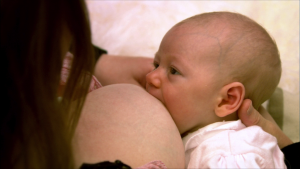For a good latch follow these steps - described in more detail below:
Keep your baby close, supporting his neck but allowing his head to move.Getting your baby to latch on properly to your breast is the key to painless and effective breastfeeding.
Here are some top tips from our experts to improve your baby’s latch.

If you are able to in the first hour after the birth, try to offer your baby his first breastfeed. Babies who are offered a feed soon after the birth will often display an instinctive feeding behaviour, including using their arms to crawl to the breast, rooting for the nipple and achieving a spontaneous latch. ‘Golden Hour’ feeding also stimulates your oxytocin production which will in turn stimulate your milk production.
If you use your own tongue to feel the roof of your mouth, right at the back, you will find a soft squishy bit. This is where the nipple should be in your baby’s mouth. If your nipple ends up on the baby’s hard palate at the front it can quickly become sore for you.
This means your nipple only just slips underneath your baby’s top lip and their bottom lip is at a distance away from it. As a result, he should take a big mouthful of breast so that he is not just sucking on the nipple.

Let’s assume to start off with that you’re going to use the classic cradle hold, where you hold your baby across your body, cradled in your arms.
You need to support the baby’s neck and shoulders (not the head) so that your baby is free to throw his head back and come in towards the breast chin first.
Try to get your baby in really close and in a nice straight line, facing the breast. Your baby will open his mouth really wide.
As soon as he does this, he’ll come in close and latch on.
You need to learn to wait until your baby’s mouth is really wide open, at which point you bring him quickly towards the nipple. Remember – he will have opened his mouth wide and thrown his head back and will then come to the breast chin first. Then he’ll scoop up a really big mouthful of breast so that the nipple will end up on that soft cushion at the back of his mouth.

Latching on properly means a quick feed and no pain.
If your baby is properly attached at the breast there shouldn’t be any pain or pinching. However, it is an unusual feeling that takes a little bit of time to get used to.
There might be an odd sensation when they first latch on, but after 10 seconds or so it shouldn’t be painful at all as your nipple should have been drawn into the soft cushion area at the back of your baby’s mouth.
Your baby will look like he has big cheeks because his mouth will be full of your breast. There should be a steady sucking rhythm.
You should be able to hear your baby swallowing milk.
Lots of mums worry that if their baby’s nose is pressed against the breast, they might not be able to breathe.
If your baby is free to throw back his head then he’ll simply just pull himself off if he can’t breathe. That’s one of the main reasons for you not to hold onto him too tightly!
It looks simple enough, and once you’ve been shown how to do it properly, and had some practice, it is. But it’s not something you’ll necessarily just be able to do instinctively, and a good or bad latch makes a big difference to how well breastfeeding goes.
Midwives, health visitors, lactation consultants or breastfeeding counsellors in your local community are all there to help you. Get some guidance up front, and go back as often as you need for help, lessons and advice afterwards.
Without a good latch, your baby won’t feed as well and become hungry and unsettled, and you might get very sore nipples or have other problems. This is one of the main reasons that new mums give up breastfeeding.
The good news is that as soon as your baby learns to latch on properly, breastfeeding becomes easy and comfortable. The more help you get upfront, the quicker this will happen.
To recap, you need to support your baby so he can get a big mouthful of breast. Here’s how: